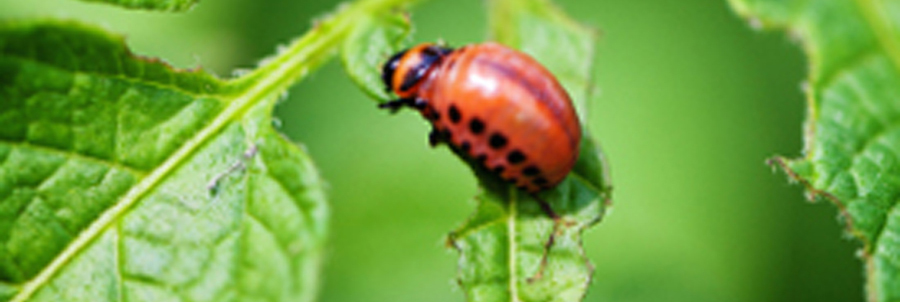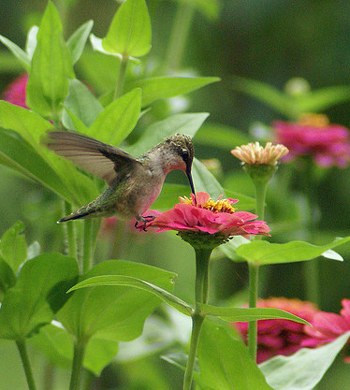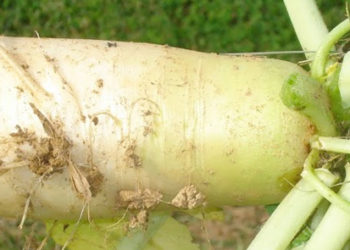 In this follow-up to Natural Pest Control we’ll tell you some additional methods that will help make your backyard a Garden of Eden, not a garden that’s been eaten!
In this follow-up to Natural Pest Control we’ll tell you some additional methods that will help make your backyard a Garden of Eden, not a garden that’s been eaten!
But before we begin, it’s important to note that the best defense is a good offense. Just as you’re less likely to catch a cold if you’ve been eating well, sleeping well, and getting regular exercise, plants are less likely to succumb to disease and insect attack if they’ve been living in nutrient-rich, well-weeded soil, and are receiving ample sun and water. Actually, pest control begins even before that with the choice of which varieties of plants to grow because some are much more pest and disease resistant than others. So pay attention to the hardiness ratings of plants, and choose wisely. Buy pre-grown plants from a company like ours that guarantees your plants will arrive healthy and disease-free. Then make sure your soil is healthy and that your plants are getting all the sun and water they need.
Less is More When Eliminating Pests
When we think of getting rid of pests, we think pesticides, but it wasn’t always that way. The Pilgrim Fathers and Native Americans managed their pests without pesticides and were still able to grow all the beautiful produce that went into those legendary Thanksgiving feasts.
The fact is, there are 200 million insects for every human being on the planet. Eighty percent of them are harmless, quite a few are beneficial, and only a small percentage go after our plants and trees. The ideal in organic gardening is to control only those bugs causing problems while not harming beneficial insects such as the ladybug, praying mantis, lacewing, aphid midge, parasitic wasp, rove beetle, and soldier beetle.
First Things First
The first step in dealing with a pest problem is to figure out what the pest is. The National Gardening Association has a Pest Control Library that contains mug shots of all the usual suspects.
The next step is to watch and see what’s happening. Where is the bug and what is it doing? In some cases the pest might not be causing damage. For example, it might be eating your broccoli leaves but leaving the head and stalk alone. The idea is to intervene only if there is a problem, and then, only with enough force to solve the problem.
Fingerpicking Basics
Just as we weed our gardens regularly, the simplest, most sustainable way to control pesky insects is to simply pick them off by hand.
Sometimes that’s all you need when it comes to controlling larger insects such as Colorado potato beetles, Japanese beetles, earwigs, cucumber beetles, stinkbugs, and weevils. Catch them in the early morning when they are cool and sluggish, or capture night feeders just before sunset as temperatures start to drop.
If you’re dealing with significant numbers, shake the plants and catch the insects on a sheet or drop cloth. Then vacuum them up with a car vacuum and drop them into a bucket of soapy water.
Some organic gardeners vacuum the bugs directly off the leaves. This works with larger insects as well as those that tend to be too small to hand pick such as tarnished plant bugs, leafhoppers, whiteflies, and sow bugs. Move the vacuum gently over the tops of your vegetable and ornamental plants, taking care not to damage any leaves.
Hydro Power
A garden hose can be an effective way to knock aphids and other unwelcome guests right off their perches in your garden. With moderate force, direct a stream of water at your plants, bombarding the pests but taking care not to hurt the plants. Keep the spray moving and be sure to get the plants’ undersides. Spray daily but not during hot, humid, wet weather, as this will encourage leaf rot, mildew, and other plant diseases.
Floating Row Covers
 Another great non-chemical pest solution is to use plant covers and row covers. These are made of a Spunbond polyester fabric that allows light, air and water to get through but not bugs. By simply covering your rows in this way, you will prevent bugs from getting on the plants. To learn the ins and outs of using row covers, check out this short article at organicgardening.com.
Another great non-chemical pest solution is to use plant covers and row covers. These are made of a Spunbond polyester fabric that allows light, air and water to get through but not bugs. By simply covering your rows in this way, you will prevent bugs from getting on the plants. To learn the ins and outs of using row covers, check out this short article at organicgardening.com.
Neem Oil
Neem oil is a derivative of an Asian evergreen tree. Its natural steroidal properties interfere with the insects’ appetite as well as their egg laying cycle. It is most effective on young (immature) insects, especially those that grow rapidly such as squash bugs, Colorado potato beetles and Mexican bean beetles. It also works on aphids and many varieties of small, leaf-eating caterpillars, whiteflies, aphids, thrips, fungus gnats, caterpillars, beetles, mushroom flies, mealy bugs, leaf miners, and gypsy moths. It will not affect ladybugs, butterflies, spiders, bees, or other insects that help pollinate plants, and it will not harm fish if it gets into the groundwater.
Insecticidal Soap
Insecticidal soap is highly effective on small, soft-bodied insects (the kind that squish rather than crunch) if sprayed directly on them. (It has no effect if only sprayed on the plant.) It works best on aphids, mealy bugs, thrips, scale crawlers and spider mites, but it can also produce good results with cucumber bugs, earwigs, grasshoppers, harlequin bugs, leafhoppers, mites, psyllids, sawfly larvae, soft scales, squash bugs, stink bugs, and whiteflies.
As far as toxicity, the good news is that it will not hurt bees. The bad news is that it will harm other beneficial insects like lacewings and ladybugs if it is sprayed on their larvae. It also can burn the foliage of sensitive plants.
Diatomaceous Earth
 Food grade diatomaceous earth is a naturally occurring substance consisting of the remains of tiny fossilized water plants. If applied around the perimeter of the plants or rows you want to protect, it will act as a barrier to crawling insects. DE can also be sprinkled on and around the infested plant. It is effective on aphids, whiteflies, beetles, loppers, spider mites, leafhoppers, and many other pests.
Food grade diatomaceous earth is a naturally occurring substance consisting of the remains of tiny fossilized water plants. If applied around the perimeter of the plants or rows you want to protect, it will act as a barrier to crawling insects. DE can also be sprinkled on and around the infested plant. It is effective on aphids, whiteflies, beetles, loppers, spider mites, leafhoppers, and many other pests.
The downside of DE is that it can be harmful to bees, butterflies, and other desirable insects. Use only enough to get the job done and apply it late in the evening when bees and other beneficial insects are at a minimum. Avoid using it around any blossoming plants and flowers or anywhere you see bees.
Hot Pepper Spray
A little further up on the toxicity scale is hot pepper spray. The active ingredient is the same one that gives hot peppers their heat. It will get rid of aphids, cabbage loopers, beet armyworms, spider mites, whiteflies, and many other insects, and has the unique characteristic of repelling birds, voles, deer, rabbits, and squirrels.
The concerns with hot pepper spray are the same as with DE, plus it could end up harming fish, so be sure to keep it away from all standing water, and don’t apply it before a rain. Also, be careful on windy days; if some gets in your eyes you’ll be in for a very unpleasant time.
Learning More
In an earlier newsletter we explored other methods of natural pest control such as planting native plants and companion planting.





No Comments